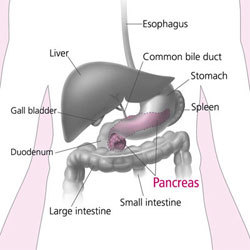Steve Jobs and the Celebrity Diagnosis Complete Guide to Tumors of the Pancreas

A friend of the family said the cause was complications of pancreatic cancer.
-New York Times…[In] recent years Jobs had fought a form of pancreatic cancer and had a liver transplant.
-ABCNewsIn 2004, he announced to his employees that he was being treated for pancreatic cancer.
-CNN
These quotes are just three of the hundreds, if not thousands, of statements made by news media about the cause of death of Apple founder Steve Jobs.
For a public figure as well-known as Jobs, the media had a responsibility to “get it right” and to explain the medical facts behind the headlines to increase the health literacy of the public. With one exception, the mainstream media had a very poor showing in both regards.
Our mission at Celebrity Diagnosis is to use the unique circumstances surrounding the health and illnesses of those in the public eye as “teachable moments in medicine,” and in so doing, increase your health awareness and medical knowledge.
When people hear the term “pancreatic cancer,” they think of the disease that killed Patrick Swayze, Pernell Roberts, William Saffire and others: One day you’re fine, next you feel a little off and go to the doctor who gives you the horrendous diagnosis, and you’re dead within weeks or months.
This is the most common kind of cancer, that doctors call pancreatic adenocarcinoma. It is NOT the kind of cancer Steve Jobs had - he had a much rarer type of tumor called an neuroendocrine tumor. Although it did arise in the pancreas, it originated from a different pancreatic cell and had a different prognosis and treatment.
So let’s start at the beginning…
 What is the pancreas and what does it do?
What is the pancreas and what does it do?
The pancreas is a fish-shaped organ (with a head to the right and tail to the left) which lies behind the stomach. It is made up of two types of cells:
1. Exocrine cells: These cells produce a pancreatic juice that includes enzymes which aid in the digestion of food in the small intestine, breaking up proteins,carbohydrates and fats.
2. Endocrine cells: These are clustered in small groups (called the Islets of Langerhans) scattered throughout the pancreas. These cells produce important hormones such as insulin, glucagon, and somatostatin.
Islet Cell (Neuroendocrine) Cancer of the Pancreas
An islet cell tumor is a mass of abnormal cells that forms in the endocrine (hormone -producing) tissues of the pancreas. Islet cell tumors may be benign (noncancer) or malignant (cancerous). Islet cell cancer is rare- only about 5% of pancreatic cancers start here.
When islet cells in the pancreas become cancerous, they may make too many hormones. Islet cell cancers that make too many hormones are called functioning tumors. Other islet cell cancers may not make extra hormones and are called nonfunctioning tumors. Seventy-five percent of islet cell tumors are functioning tumors.
Functional Islet Cell Tumors are often named after the hormone they produce:
- Gastrinoma -The tumor makes large amounts of a hormone called gastrin, which causes too much acid to be made in the stomach. Ulcers may develop as a result of too much stomach acid.
- Symptoms: Abdominal pain, diarrhea, ulcers in the stomach and small bowel and occasionally vomiting blood
- Insulinoma -Overproduction of the hormone insulin and causes the body to store sugar instead of burning the sugar for energy. This causes too little sugar in the blood, a condition called hypoglycemia.
- Symptoms: Feeling tired or weak, shakiness, sweating, headache, hunger, nervousness, double or blurry vision, and fast or pounding heartbeat
- If your blood sugar gets too low, you may faint, have a seizure, or even go into a coma.
- Glucagonoma - This tumor makes too much of the hormone glucagon and causes too much sugar in the blood, a condition called hyperglycemia.
- Symptoms: Diabetes (present in most of the patients), inflamed mouth and tongue, and a crusty or scaly skin rash on the face, abdomen, buttocks, or feet - which may be filled with clear fluid or pus
Surgery is the most common treatment of islet cell cancer. The doctor may take out the cancer and most or part of the pancreas. Sometimes the stomach is taken out (gastrectomy) because of ulcers. Lymph nodes in the area may also be removed and looked at under a microscope to see if they contain cancer.
If malignant cancer cells spread , they tend to go to the liver, and a portion of the liver may also be removed, if possible. Research has suggested that since the tumor is slow growing, even when present in the liver, that liver transplantation is a reasonable option for islet cell cancer patients with spread to the liver. (Steve Jobs underwent a liver transplant in 2009)
If the cancer is widespread, various forms of chemotherapy may be used to try and shrink the tumors.
The prognosis for islet cell tumors is generally better than adenocarcinomas. Average life expectancy has been stated as 5-10 years. They tend to be slower growing tumors. Also, because the hormones they produce cause symptoms, they are often caught at an earlier stage. Surgery may be curative if found before there is any spread elsewhere.
Pancreatic Adenocarcinoma
Pancreatic adenocarcinoma is a cancerous overgrowth of exocrine pancreatic cells (see above).
Pancreatic cancer is the fourth leading cause of cancer death for both men and women.
- Pancreatic cancer is one of the most deadly of all types of cancer.
- This year 44,030 Americans will be diagnosed with pancreatic cancer and about 37,660 will die from it.
- Despite the high mortality rate, the federal government spends woefully little money on pancreatic cancer research.
Pancreatic cancer is treatable when caught early; the vast majority of cases are not diagnosed until too late.
- Five-year survival rates approach 40% if the cancers are surgically removed while they are still small and have not spread to the lymph nodes.
Pancreatic cancer is difficult to diagnose
- There is no reliable screening test for the early detection of pancreatic cancer.
- Symptoms are often vague and easily confused with other diseases:
- Dark urine and clay-colored stools
- Fatigue and weakness
- Jaundice (a yellow color in the skin, mucus membranes, or eyes)
- Loss of appetite and weight loss
- Nausea and vomiting
- Pain or discomfort in the upper part of the belly or abdomen
- Back pain
- Blood clots
- Diarrhea
- Indigestion
Who Has the Greatest Risk?
Inherited genetic disorders cause 5-10% of cases of pancreatic cancer and certain genes can inrease the lifetime risk up 80%.
- People with two or more relatives who have had pancreatic cancer
- Cigarette smokers
- People of Ashkenazi Jewish descent
- Have the BRCA2, p16, STK11 gene mutation or chronic pancreatitis (inflammation of the pancreas)
- Are over the age of 50
Because pancreatic cancer is often advanced when it is first found, very few pancreatic tumors can be removed by surgery. The standard surgical procedure is called a pancreaticoduodenectomy (Whipple procedure).
When the tumor has not spread out of the pancreas but cannot be removed, radiation therapy and chemotherapy together may be recommended.
When the tumor has spread (metastasized) to other organs such as the liver, chemotherapy alone is usually used. The standard chemotherapy drug is gemcitabine, but other drugs may be used. Gemcitabine can help about 25% of patients.
Managing pain and other symptoms is an important part of treating advanced pancreatic cancer. Palliative care tams and hospice can help with pain and symptom management, and provide psychological support for patients and their families during the illness.
More extensive information is available by visiting these Resounding Health Casebooks:
| Resounding Health(tm) Neuroendocrine (islet cell) tumor |
| RESOUNDING HEALTH(tm) Pancreas Cancer |

























1 Comment